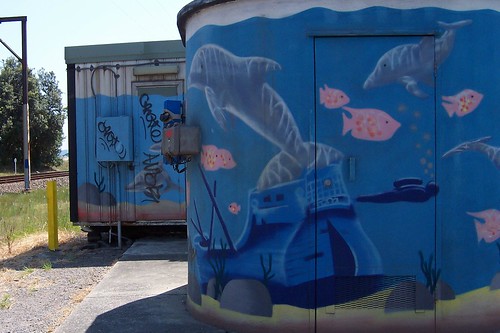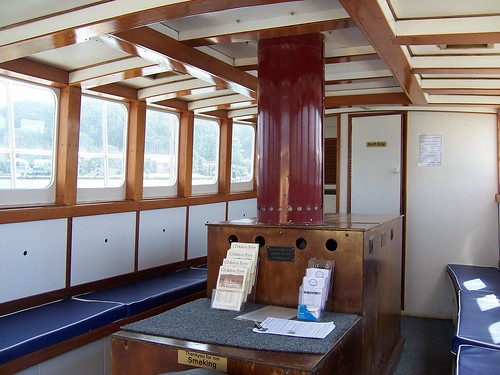
Take the ferry, the
Saratoga or the Codock II, from
Woy Woy Wharf to the first ferry stop in Lintern Channel, Veterans Hall. When you get off you're on Henderson Road Saratoga. Head right along the waterfront. There's a nice new path there. The road will curve then come to a corner and right there at that corner is a tiny cemetery. It's my very favourite cemetery in the area, topping even
St Paul's,
Kincumber South and
Point Clare.

Veteran Hall and Veterans Hall are the same place. Locals tend to say Veterans Hall. It was the name of Robert and Catherine Henderson's house and the ferry wharf nearby still has the name. The house was on the slope above the wharf as far as I can tell, maybe 300 yards from the cemetery and to the right of the photo above. It was a sandstone place and probably quite pleasant but it was knocked down in 1909. A newspaper article of 1909 described it as:
"...a very old homestead of the farmhouse type, with shingled roof and attics, deep verandas and wide stone hall".
Sounds very similar to
Rock Davis's old place in Orange Grove Road. That's still standing.
Robert Henderson was one of the local movers and shakers. His parents came out from Ireland on the
Sugar Cane as convicts in 1793. He was born at Parramatta (now a suburb of Sydney) in 1796 and married Catherine Geary there in 1817. Robert got a land grant at
Pittwater near Palm Beach. His father-in-law had a land grant at Brisbane Water, a short boat trip away. Robert and Catherine moved there in the first few years of white settlement. They named their house Veteran Hall in honour of her father's time as a private in the New South Wales Corps (early colonial army-cum-police-cum-prison guards).

Robert had several careers. In 1824 he was appointed District Constable. This was something like the job of sheriff in the Hollywood movies I gather. He and Catherine cleared their land and began to farm. They bought more local land and Robert left the police in 1829. The farm was still running and the 1828 Census has it at 500 acres and 14 male employees. He went into shipbuilding and nearly got done for rum smuggling. He popped back to Sydney for a bit then came back and was appointed to the District Council in 1850 or 1854. Around 1842 there was a school at Veteran Hall. Not in the house itself by the look of it. He popped off for good in November 1869, of cancer of the face, and is buried in this wee cemetery.
(Info from Six Brisbane Water Cemeteries: A heritage tour, by Jillian Baxter (1992), Historical Records of the Central Coast of NSW: Bench Books & Court Cases: 1826-74, published by the Gosfrod District Local History Study Group (1990) & The Shipbuilders of Brisbane Water NSW by Gwen Dundon (1997).)

The stone set against the wall reads:
"This land enclosed by wall of stone is bequeathed and willed by me to the dead who sleep within its walls during eternity
Robert Henderson Brisbane Water September 1869".
As you can see, the cemetery's not set apart from the houses in any way now. In 1869 it would've been a different matter. I'm not sure how many houses would've been in Saratoga but I'm guessing less than five on this side of the hill.
The houses you can see in the background are on Henderson Road, Fernview Avenue and Treeview Place, Saratoga. Fernview and Treeview have views across to Woy Woy with
Rileys Island,
St Huberts Island and
the unnamed isles in between. Not the very best views on Brisbane Water but well worth the dosh.

The closest headstone reads:
"Sacred
to the memory of
Elizabeth Catherine
Henderson
the dearly beloved wife of
Robert Henderson
who departed this life
30th [?] of August 1884 [?]
aged [?] years
[then the quote, possibly biblical]"
To Elizabeth Catherine's right are Letitia Catherine Henderson and Florence [Madeline?] Henderson. The rest are illegible.
Bakewell's Index of Combined Central Coast Cemeteries has a list of the occupants:
Patrick Geary, died 7th of January 1827 aged 63. (One of the earliest white burials in the area.
John Jacob Pester [Pister in some books], died 10th of July 1832 aged 52.
Thomas Daily, died 22nd of August 1837 aged 85.
Catherine Hargraves, died 3rd of August 1866 aged 18.
Annie Cox, died 7th of May 1867 aged 5.
Robert Cox, died 26th of February 1868 aged 2 years and 6 months.
Florence Henderson, died 23rd of April 1868 aged 8 years 11 days.
Letitia Henderson, died 26th of April 1868 aged 5 years 1 month.
Hannah Henderson, died 16th of July 1868 aged 39.
Michael Cox, died 17th of November 1868 aged 65.
Catherine Henderson, died 29th of November 1868 aged 68.
Robert Henderson, died 11th of November 1869 aged 73.
Thomas Henderson, died 29th of May 1870 aged 32.
Elizabeth Henderson, died 30th of August 1885 aged 43.
Madeline Ward, died 2nd of May 1934 aged 80.
A lovely little cemetery.
I'm glad I got out and walked today. The weather was iffy but there were sunny patches as you can see.
I've been cooped up indoors too much lately. Lots of indoor stuff to do before the end of February. It's the ideal time to do it. February heat is crap. I walked bugger-all
this time last year as well. Bring on winter, for fuck's sake.
Mystery solvedUmina Rampart says Wednesday's fire was in the tip (garbage dump) which is off the end of Nagari Road. Ta, mate.


































